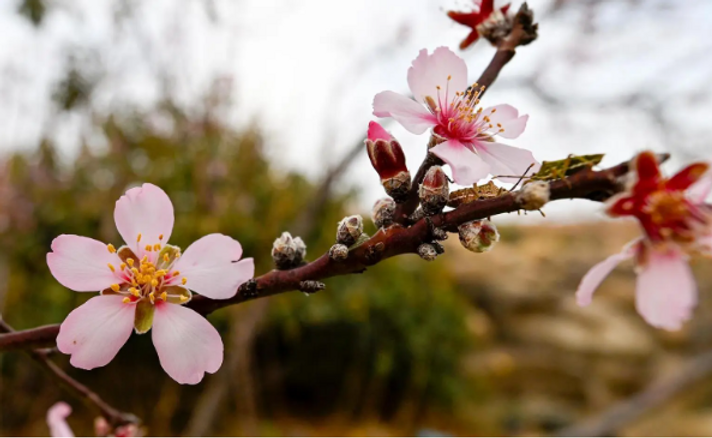
Newsletter Subscribe
Enter your email address below and subscribe to our newsletter

Enter your email address below and subscribe to our newsletter

**Título:** “Almond Blossoms Transform Taif Mountains”
**Intro:** The Bajali almond trees of Bani Malik villages, south of Taif, have erupted in a sea of white blooms, marking spring’s arrival. These hardy trees, flourishing in the Maysan Governorate’s cold climate, not only paint the rugged terrain but also sustain local livelihoods, drawing tourists and symbolizing Saudi Arabia’s natural and cultural heritage.
**Factbox (50w):**
– **Location:** Bani Malik villages, Maysan Governorate (Taif).
– **Bloom Period:** Late January to March; fruits ripen by June.
– **Yield:** 100–150 kg per tree annually.
– **Significance:** Low-water, cold-resistant trees boost eco-tourism and farmer incomes. Highlighted by SPA for environmental and cultural value.
**Title: The Blossoming Splendor of Bajali Almond Trees: Taif’s Springtime Jewel**
**Introduction: A Springtime Awakening in Bani Malik**
As winter’s chill recedes, the highlands of Taif come alive with the ethereal beauty of Bajali almond trees. Nestled in the Bani Malik villages of Maysan Governorate, these trees blanket the rugged terrain in a sea of white blossoms each spring, signaling nature’s renewal. Their delicate fragrance and snow-like blooms create a mesmerizing spectacle, drawing admirers to witness one of Saudi Arabia’s most enchanting natural phenomena.
—
**1. The Bajali Almond: A Testament to Nature’s Resilience**
The Bajali almond tree (*Prunus dulcis*) thrives in Taif’s cold mountainous climate, adapting seamlessly to arid conditions with minimal water needs—a trait that underscores its ecological importance. From late January to March, the trees erupt in fragrant white flowers, which later develop into small, green-membraned fruits encased in hardy shells. By June, these fruits ripen into nutrient-rich almonds, yielding 100–150 kg per tree annually. Their ability to flourish in harsh environments makes them a symbol of resilience and sustainability.
—
**2. Economic Lifeline for Local Farmers**
For generations, Bajali almonds have been a cornerstone of livelihood in Bani Malik. The trees’ high yield and low maintenance offer farmers a profitable crop, with each season’s harvest contributing significantly to local economies. Beyond direct sales, almonds are processed into oils, sweets, and traditional medicines, adding value to this versatile produce. As global demand for sustainable crops grows, these almonds position Taif as a key player in agro-tourism and organic farming.
—
**3. Cultural Heritage Blossoms Anew**
Deeply rooted in local traditions, Bajali almond trees are a cultural treasure. Families, including children, engage in age-old practices of planting and preserving these trees, passing down knowledge through generations. The almond harvest season becomes a communal celebration, blending storytelling, folk songs, and culinary traditions. As one farmer noted, *“These trees are not just crops—they’re part of our identity.”*
—
**4. Ecotourism: Where Nature Meets Adventure**
The Saudi Press Agency (SPA) recently spotlighted the Bani Malik Mountains as a burgeoning ecotourism hotspot. Visitors flock here to:
– **Hike** through almond-blossom trails.
– **Photograph** the surreal landscape during peak bloom.
– **Savor** fresh almonds and local dishes in rustic mountain villages.
Adventure seekers and nature lovers alike are drawn to the region’s untouched beauty, bolstering Taif’s reputation as a year-round destination.
—
**5. Guardians of Biodiversity**
Beyond their visual appeal, Bajali almond trees play a vital ecological role. Their deep roots stabilize soil, preventing erosion in mountainous areas, while their blossoms provide nectar for pollinators. This synergy supports biodiversity, creating habitats for birds and insects and maintaining the delicate balance of Taif’s ecosystem.
—
**Conclusion: Preserving a Legacy for Tomorrow**
The Bajali almond trees of Taif are more than a seasonal marvel—they are a living mosaic of ecology, economy, and heritage. As Saudi Arabia advances its Vision 2030 goals, initiatives to protect these trees and promote sustainable tourism will ensure their legacy endures. For travelers and locals alike, a visit to Bani Malik during bloom season is not just a journey through nature, but a step into the heart of Saudi culture.
**Explore. Taste. Preserve.**
*Plan your spring adventure to Taif and witness the Bajali almonds in their full glory—a fleeting masterpiece of nature.*
—
**SEO Keywords**: Bajali almond trees, Taif spring blossoms, Bani Malik ecotourism, Saudi cultural heritage, sustainable farming Saudi Arabia, almond harvest season, Maysan Governorate tourism.
**Blockquote Emphasis**:
> *“In the shadow of these blossoms, we find our past, present, and future.”* – Bani Malik Elder
This structure balances vivid storytelling with factual depth, optimized for reader engagement and search visibility.
**FAQs about Bajali Almond Trees in Taif’s Bani Malik Villages**
1. **When do Bajali almond trees bloom in Taif?**
Bajali almond trees bloom from late January to early March, emerging from winter dormancy to adorn the Bani Malik Mountains with fragrant white blossoms, signaling the arrival of spring.
2. **Where are Bajali almond trees located in Saudi Arabia?**
These trees thrive in the mountainous terrain of the Bani Malik villages within the Maysan Governorate, south of Taif, where cold climates and low water conditions favor their growth.
3. **What distinguishes Bajali almond blossoms?**
Their blossoms are renowned for their magical beauty, snowy-white color, and delicate fragrance, transforming the landscape into a scenic canvas during spring.
4. **How do Bajali almonds develop from flowers to fruits?**
After blooming, white flowers form small fruits encased in hard shells covered by a green membrane, maturing gradually until ripening in June for harvest.
5. **What is the average yield per Bajali almond tree?**
Each tree produces 100–150 kilograms of almonds per season, making them a high-value crop for local farmers due to their abundant and consistent output.
6. **Why are Bajali almond trees economically valuable?**
Their low water requirements, high yield, and demand for almonds make them a lucrative crop, enhancing income for farmers in Taif’s mountainous regions.
7. **What climate conditions do Bajali almond trees require?**
They thrive in cold, mountainous climates with minimal water, adapting well to the harsh conditions of the Bani Malik Mountains while producing quality fruits.
8. **How do Bani Malik locals preserve almond trees?**
Families actively plant and maintain these trees on their farms, combining traditional knowledge with conservation efforts to sustain their cultural and economic benefits.
9. **Why do tourists visit the Bani Malik Mountains in spring?**
The spectacle of blooming almond trees attracts hikers, photographers, and nature enthusiasts seeking to experience the region’s enchanting landscapes and fragrant floral displays.
10. **What role did the Saudi Press Agency (SPA) play?**
SPA highlighted the environmental, cultural, and economic importance of Bajali almonds, promoting awareness of their role in tourism and local heritage.
11. **How do Bajali almonds contribute to Saudi heritage?**
They symbolize natural wealth and cultural identity, reflecting traditional agricultural practices and serving as a source of pride for communities in Taif.
12. **What are Bajali almond fruits’ characteristics?**
The fruits feature a hard shell wrapped in a green membrane, ripening by June into edible almonds known for their rich flavor and nutritional value.
13. **Why are Bajali trees considered environmentally resilient?**
As deciduous nut trees, they require little water and thrive in rugged terrains, making them sustainable for arid regions and ecologically beneficial.
14. **Why are almond trees significant to Bani Malik families?**
They represent both cultural heritage and economic stability, with families involving children in preservation efforts to ensure future generations benefit from their value.
15. **What is the Bajali almond growing season timeline?**
Blooming begins in late January, with fruits developing through March and ripening by June, marking a five-month growth cycle from flower to harvest.
**📣 CTA (Llamado a la Acción):**
¿Listo para sumergirte en un paisaje de ensueño? ¡Planifica tu visita a las montañas de Bani Malik y déjate cautivar por el espectáculo floral de los almendros Bajali! Comparte tus fotos y experiencias con el hashtag #AlmendrosDeTaif y forma parte de la celebración de esta joya natural. 🌸✨
**🌄 Conclusión:**
Los almendros Bajali no solo pintan de blanco las montañas de Taif, sino que también tejen un puente entre la naturaleza, la tradición y el desarrollo económico. Su floración, más que un fenómeno estacional, es un recordatorio de la resiliencia de la agricultura local y la riqueza natural que el Reino preserva con orgullo. Un destino que combina belleza, historia y sustento, invitándonos a valorar y proteger estos tesoros vivos.
**🙏 Agradecimiento:**
Gracias por acompañarnos en este recorrido por los paisajes únicos de Taif. Esperamos que este artículo inspire tu próxima aventura o, al menos, te acerque un poco más a las maravillas naturales de Arabia Saudita. ¡No olvides suscribirte a nuestro blog para más historias auténticas y descubre con nosotros los rincones mágicos del mundo! 🌍💚